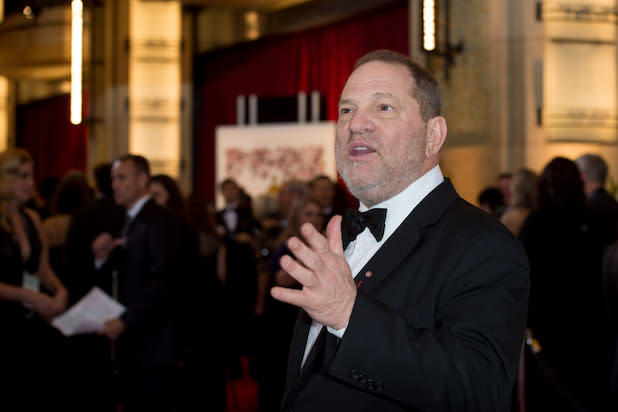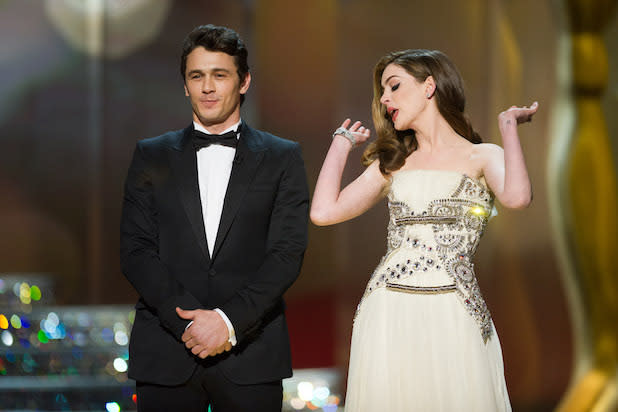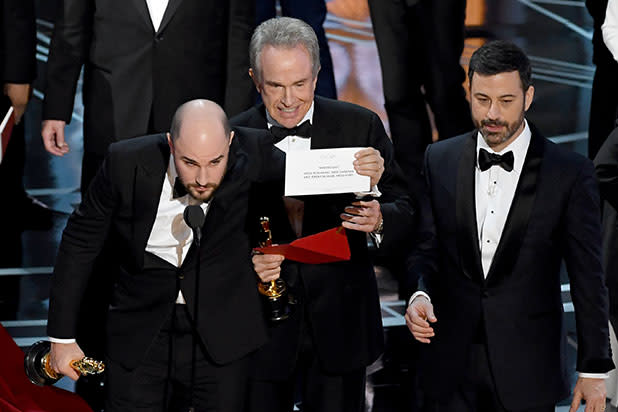8 Biggest Changes to the Oscars in the 2010s, From #OscarsSoWhite to Envelopegate
What a difference a decade makes.
At the beginning of the 2010s, the Oscars were already showing signs of change: The Academy of Motion Picture Arts and Sciences had expanded the Best Picture category from five to 10 nominees and given the Best Director award to a woman for the first time ever, while also looking for new income sources as Oscar show ratings fell and the economic downturn hit AMPAS investments.
Even so, nobody could have foreseen just how dramatically the awards, and the Academy that hands them out, would be transformed over the next 10 years. While the 1930s saw the Oscars grow from seven categories decided by committee to 20 categories and thousands of voters, and the 1950s put the Oscars on television, it’s hard to find a more transformational decade than the 2010s.
Here’s a look at the changes, which have included the profound impact of #OscarsSoWhite and #MeToo, an overhaul of its executive structure, a radical change of top management, a huge expansion of its membership and its board, a commitment to a still-unfinished museum that has cost hundreds of millions of dollars, a decision to institute a code of conduct for the first time and a prolonged battle to stave off declining ratings for the Oscars telecast.
Also Read: How Many Votes Does It Take to Get an Oscar Nomination in 2020?

Academy CEO Dawn Hudson / AMPAS
1. THE EXECUTIVE SUITE
On the business side, the decade began with AMPAS executive director Bruce Davis announcing his retirement in the fall of 2010. Davis had been at the Academy for 30 years, 20 of them as the organization’s top salaried official — and his departure, which was set for the end of the fiscal year in mid-2011, threatened to shake an organization that under Davis had seemed to treasure tradition and run on institutional memory.
The Academy went outside its own ranks to find a replacement for Davis, restructuring the executive suite and naming former Film Independent director Dawn Hudson to the newly-created CEO position. Davis’ No. 2, executive administrator Ric Robertson, stayed on as COO, another new position — but over the next year, a number of longtime employees would leave the Academy. And when Robertson himself departed in September 2013, Hudson was left alone as the Academy’s top executive. Her contract was renewed by the Board of Governors in the spring of 2014, and then again in 2017, after a reportedly contentious board meeting that included an impassioned speech by Laura Dern in support of Hudson.
Also during the decade, the Board of Governors itself grew from 43 members to 54 members with the creation of the new Casting Directors Branch, the expansion of the Makeup Artists and Hairstylists Branch from one to three governors, and the introduction of three governors at large. The larger size of the board led to complaints from some governors that board meetings had become increasingly unmanageable — and the exit of some key longtime members of the Academy leadership for many years through resignation (Bill Mechanic) or opting not to run for re-election (Kathleen Kennedy).
Academy presidents during the decade were producer and executive Tom Sherak; the first second-generation Academy president, Hawk Koch; the third woman and first African-American to hold the position, Cheryl Boone Isaacs; the first cinematographer to serve as president, John Bailey; and the first openly gay president, casting director David Rubin.
Also Read: Here's What's on My Oscar Season Christmas Wish List: Eddie Murphy, 'A Hidden Life' and Lots More

Academy Museum sketch / AMPAS
2. THE MUSEUM
The Academy had been thinking about building a museum dedicated to motion pictures for decades, and even paid $50 million for a 3.5 acre site in Hollywood for that purpose until the 2008 economic downturn caused it to abandon those plans. But in the fall of 2011, the board signed an agreement with the Los Angeles County Museum of Art to locate an Academy Museum of Motion Pictures in the old May Co. building on the LACMA campus. It launched a $100 million fundraising campaign to get the project off the ground, announced that Renzo Piano and Zoltan Pali would collaborate as architects of the building and released sketches of their design in October 2012.
Money came in from major donors, including $50 million from Cheryl and Haim Saban, $25 million from David Geffen and $20 million from Dalian Wanda — but the projected cost grew to nearly $400 million, and by the end of the decade the Academy took on hundreds of millions in debt to keep the project alive. Pali resigned as one of the architects in 2014, reportedly after conflicts with Piano, and the projected opening date moved from 2017 to spring 2018 to late 2019.
In June 2019, AMPAS announced the museum’s opening would be delayed again to sometime after the Oscars in 2020.
Also Read: 2020 Oscar Contenders, From Awkwafina to Renee Zellweger (Exclusive Photos)

Spike Lee at the Governors Awards / Getty Images
3. THE MEMBERSHIP
For years, the Academy had capped its annual invitations to new members to keep the number of Oscar voters around 5,000. But with voting privileges lasting for a member’s lifetime, it was hard to bring in much new blood — and in the 2010s, new blood became desperately needed, particularly after the #OscarsSoWhite movement was launched.
The warning signs began to grow ominous in early 2012, when the Los Angeles Times published the result of a year-long study that showed, to nobody’s surprise, that the Academy was largely male, white and old. The following year, in an attempt to make the Academy more diverse, the Board of Governors agreed to lifts the limits on new member invitations, and the individual branch committees were actively lobbied by Hawk Koch and Dawn Hudson to invite more women and nonwhite members.
In November 2015, as he was receiving an Honorary Oscar at the Academy’s Governors Awards, Spike Lee slammed Hollywood for its “ridiculous” lack of diversity. And two months later, the Academy announced its nominations — which for the second straight year did not include a single person of color in the four acting categories. The outcry was immediate, and the #OscarsSoWhite hashtag was born.
On Martin Luther King Day 2016, Academy president Cheryl Boone Isaacs released a statement promising “dramatic steps to alter the makeup of our membership.” Those steps, she soon detailed, included a pledge to double the number of female and nonwhite members by 2020, the addition of three new members to the Board of Governors and a requirement that members remain active in the industry or lose their right to vote for the Oscars.
That June, the Academy invited 683 film professionals to join, by far the largest and most diverse group of prospective new members ever. For the first time, it also revealed the ethic and gender breakdown of its membership: 75% male and 92% white. But 46% of the invitations that year went to women, and 41% to people of color. The record for new member invitations was broken again in 2017, when 774 were invited to join, and in 2018, when 928 received invites. By the time an additional 842 people were invited in 2019, 50% of them women, the Academy had gone well past its goal of doubling the number of nonwhite members, while putting the goal of doubling the number of women within reach.
In the three batches of Oscar nominations between the #OscarsSoWhite furor and the end of the decade, 14 of the 60 acting nominees were nonwhite — and four of them won.

Harvey Weinstein at the Oscars in 2015 / AMPAS
4. ROGUE MEN
Since “My Left Foot” and “Cinema Paradiso” won Oscars in the early 1990s, Harvey Weinstein had been a fixture at the Oscars. He turned awards campaigning into a contact sport and won Best Picture Oscars for “The English Patient,” “Shakespeare in Love,” “Chicago” and, in the 2010s, for “The King’s Speech” and “The Artist” in back-to-back years, 2011 and 2012.
But in October 2017, the New York Times and the New Yorker published detailed accounts accusing Weinstein of years of sexual misconduct. The stories help launch the #MeToo movement — which put the Academy, which had never expelled a member for behavior not released to AMPAS business, in the situation of either becoming a moral arbiter or appearing to ignore Weinstein’s conduct.
It chose the former option, expelling Weinstein and then instituting its first-ever code of conduct. The document read, in part, “There is no place in the Academy for people who abuse their status, power or influence in a manner that violates recognized standards of decency,”
Five months later, responding to additional pressure, the Board of Governors voted to expel Bill Cosby and Roman Polanski as well.

Kathryn Bigelow accepts the Best Director Oscar from Barbra Streisand in 2010 / AMPAS
5. THE AWARDS
While the Academy itself was fundamentally altered, the awards it gives out were undergoing their own changes. It started with the move to 10 Best Picture nominees, which was tried in 2010 and 2011 and led to nominations for a number of films that would not otherwise have been recognized, including crowd-pleasers “The Blind Side,” “District 9” and “Toy Story 3” and indies “An Education,” “A Serious Man” and “Winter’s Bone.”
But after two years, the board voted for a new system that would provide a variable number of nominees. In theory, it was supposed to produce anywhere between five and 10 nominees; in practice, it has always produced eight or nine.
Also in the decade, the Academy instituted online voting that began for the 85th Oscars in 2013, and overhauled voting in the Best Documentary Feature and Best Foreign-Language Film categories. (At the end of the decade, the last category’s name changed to Best International Feature Film so as not to use the potentially pejorative word foreign.)
Voters’ choices, meanwhile, provided a number of firsts: the first African-American winners in the animated feature, documentary feature, documentary short, animated short, costume design, production design and screenplay categories; the first Best Picture winner, “12 Years a Slave,” to have a black director (Steve McQueen) producer (McQueen) and writer (John Ridley); the first Asian winner of Best Makeup and Hairstyling (Kazuhiro Tsuji for “Darkest Hour”); and the first black African woman ever to be nominated and to win (Lupita Nyong’o for “12 Years a Slave”).
And the Best Director category alone provided a lesson in diversity. In March 2010, Kathryn Bigelow became the first woman ever to win in the category — and the 10 Best Director prizes handed out during the decade went to a woman, Bigelow; a Taiwanese-born director, Ang Lee; and three Mexican directors who between them won five awards: Alfonso Cuarón twice, Alejandro G. Inarritu twice and Guillermo del Toro once. The other three winners were British director Tom Hooper, French director Michel Hazanavicius and American director Damien Chazelle, at 32 the category’s youngest winner ever.
It was the first time in 80 years that the majority of Best Director winners had come from outside the United States — and the last time that happened, in the 1930s, the six non-American directors had all been born in Europe but were living and working in the U.S.

2011 Oscar hosts James Franco and Anne Hathaway
6. THE OSCAR SHOW
If it was a good decade for firsts when it comes to Oscar winners, it wasn’t a particularly good one for Academy Awards shows. Ratings dropped by almost 25% over the course of the decade, despite a peak in 2014 when Ellen DeGeneres hosted. Hosts like Seth MacFarlane, the duo of James Franco and Anne Hathaway and even Neil Patrick Harris were criticized for lackluster (or, in Franco’s case, comatose) performances.
Two other hosts dropped out — Eddie Murphy after the man who’d hired him, producer Brett Ratner, resigned after using an anti-gay slur and giving a sexually explicit interview to Howard Stern, Kevin Hart after being criticized for past homophobic tweets.
Craig Zadan and Neil Meron produced three of the decade’s shows, after one-term AMPAS president Hawk Koch gave them an unprecedented (and unpublicized) three-year contract; otherwise, a new pair of producers tackled the thankless gig every year.
So when “The Shape of Water” won Best Picture and the show in 2018 fell below 30 million viewers for the first time in history, ABC put serious pressure on the Academy to reverse what appeared to be an inexorable downward trend. At the August board meeting that year, the governors, desperate to do something, voted to hand out a “Popular Oscar,” to give out some awards off the air and to guarantee a three-hour show. None of the ideas were fully worked out, but they were announced immediately and promised for the upcoming show.
A month later, the Academy announced that it was tabling the “Popular Oscar” idea for further study. The plan to hand out awards during commercial breaks lasted a few months longer — but in February, when details were revealed and Hollywood guilds slammed the plan to give out the cinematography, film editing, makeup and hairstyling and live-action short categories during commercial breaks, the Academy backed down and reinstated all 24 awards on the show.
The show went on without a host after Kevin Hart’s departure, and it went over the three-hour mark by 23 minutes. But with three $200-million-plus films (“Black Panther,” “A Star Is Born” and “Bohemian Rhapsody”) in the running for the Best Picture award that was won by “Green Book,” the audience was up more than 10% over the previous year, though it was still the second-smallest Oscar viewership ever.

The end of the Oscars in 2017 / Getty Images
7. ENVELOPEGATE
Everything else that happened on the Oscars stage in the 2010s, though, was overshadowed by a huge snafu in the Best Picture category in 2017. An apparently distracted and starstruck PwC accountant gave presenters Faye Dunaway and Warren Beatty a spare Best Actress envelope as they went on stage to hand out the Best Picture Oscar. Beatty and Dunaway opened the incorrect envelope and puzzled over it before Dunaway announced the wrong winner, “La La Land” instead of “Moonlight.”
And the accountants, who were under strict instructions to halt the show immediately if an incorrect winner was announced, instead did nothing until the “La La Land” producers had already made their acceptance speeches. “They froze,” a disgusted stage manager told TheWrap after the show.
In the aftermath, PwC accepted responsibility for the egregious mistake, booted the two accountants off the Oscar team and instituted other safeguards and changes. In return, the Academy agreed to retain the company had been counting Oscar ballots for 80-some years.

Joanna Natasegara and Orlando von Einsiedel accept Netflix’s first Oscar for “The White Helmets” in 2017 / AMPAS
8. THE STREAMING DISRUPTER
What is a motion picture, anyway? The Academy had to grapple with that question during the 2010s, largely because of one company: Netflix, which began making inroads in the nonfiction categories and ended up being a major player at the Oscars across multiple categories by decade’s end.
The company’s first Oscar nomination came in 2014 for the documentary “The Square,” followed the next year by “Virunga” and then in 2016 by two doc-feature nominees, “What Happened, Miss Simone?” and “Winter on Fire: Ukraine’s Fight for Freedom.” It broke through and won its first Oscar in 2017 for the documentary short “The White Helmets,” then received seven nominations in 2018, winning for the doc feature “Icarus.”
The breakthrough came in 2019, with Alfonso Cuarón’s “Roma” receiving 10 nominations, including the first Best Picture nom for a Netflix movie. The film won three awards, including Best Foreign Language Film. In the aftermath of that show, rumors flew that some members of the Board of Governors, notably including Steven Spielberg, were going to press for a new rule requiring the kind of theatrical run that would disqualify most Netflix releases.
But when the Academy announced its annual rule changes in April, the release pointedly stated that the board had voted to retain the existing eligibility rules, though a quote from AMPAS president John Bailey said that “the theatrical experience … weighed heavily in our discussions.”
In other words, it would be business as usual for Netflix — which, with “The Irishman,” “Marriage Story,” “The Two Popes” and “Dolemite Is My Name,” is now in position to be the most-nominated company of the 2020s.
And now, as the year and the decade ends, a record 8,469 Oscar voters — 16% of them nonwhite and 32% women — prepare to cast ballots for what will be the earliest Oscar ceremony ever.
And the museum, maybe, is close to opening.
As we said at the top, what a difference a decade makes.
Read original story 8 Biggest Changes to the Oscars in the 2010s, From #OscarsSoWhite to Envelopegate At TheWrap
